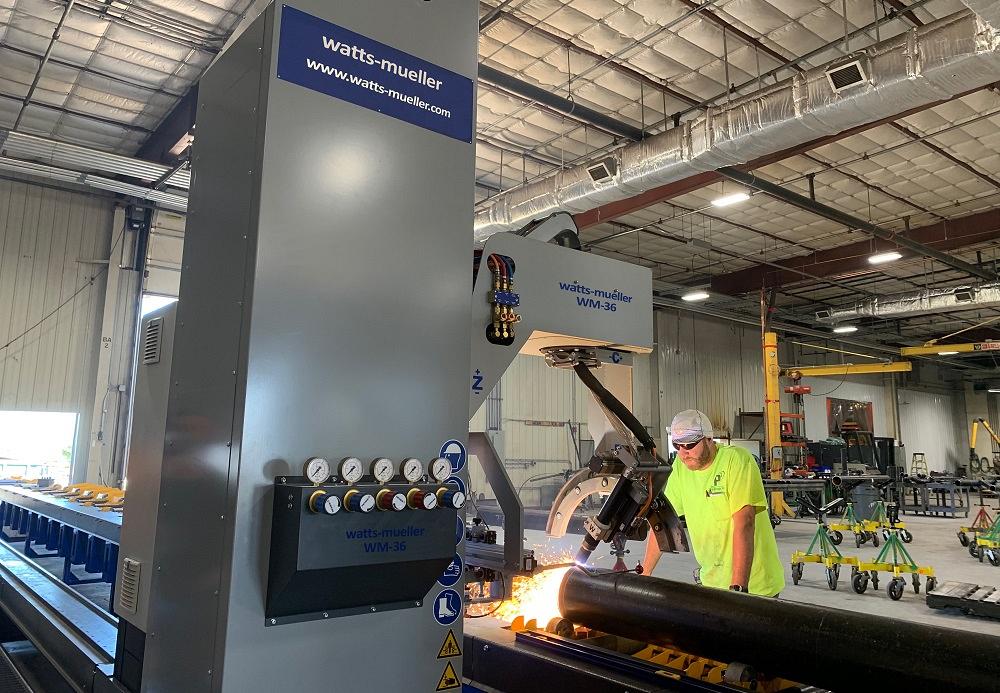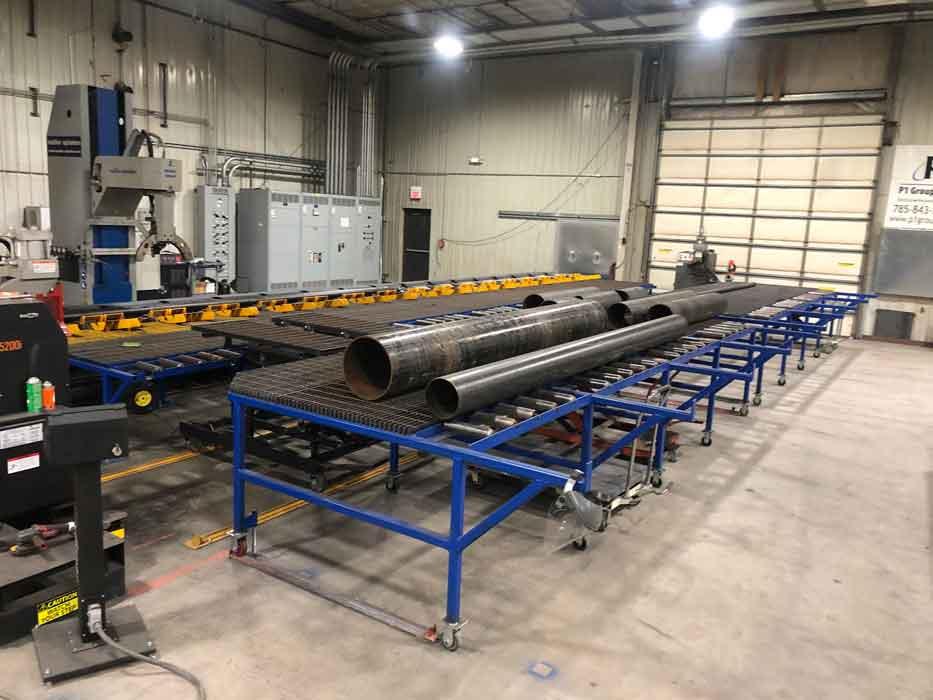Editor-in-Chief
- FMA
- The Fabricator
- FABTECH
- Canadian Metalworking
Categories
- Additive Manufacturing
- Aluminum Welding
- Arc Welding
- Assembly and Joining
- Automation and Robotics
- Bending and Forming
- Consumables
- Cutting and Weld Prep
- Electric Vehicles
- En Español
- Finishing
- Hydroforming
- Laser Cutting
- Laser Welding
- Machining
- Manufacturing Software
- Materials Handling
- Metals/Materials
- Oxyfuel Cutting
- Plasma Cutting
- Power Tools
- Punching and Other Holemaking
- Roll Forming
- Safety
- Sawing
- Shearing
- Shop Management
- Testing and Measuring
- Tube and Pipe Fabrication
- Tube and Pipe Production
- Waterjet Cutting
Industry Directory
Webcasts
Podcasts
FAB 40
Advertise
Subscribe
Account Login
Search
Speeding up pipe fabrication at P1 Group
Fab shop finds a way to eliminate multiple processes and extra material handling
- By Dan Davis
- April 21, 2020
- Article
- Tube and Pipe Fabrication

P1 Group’s new WM-36 3D pipe cutting system from Watts-Mueller has enabled the company’s fabricating shop in Lawrence, Kan., to more efficiently cut and bevel pipe sections. Images provided by P1 Group
Sometimes meetings and proper scheduling can take you only so far in a fabricating operation. As business grows, maintaining that correct balance of flexibility and on-time delivery gets tougher if the same number of people have to tackle the increased work load in the same amount of space.
P1 Group Inc.’s fab shop in Lawrence, Kan., found this to be the case in recent years. The provider of mechanical, electrical, and plumbing construction and fabrication services has been enjoying robust growth in recent years, which was putting a strain on its 45,000-sq.-ft. shop and its 25 employees.
Now that may sound like a lot of room, especially if you have worked in a garage-sized operation or a small mom-and-pop shop, but when you are talking about pipe work, that changes the discussion quite a bit. Jeremy Price, P1 Group’s pipe shop production manager, said that the shop typically works on pipe 36 in. OD and less, but it has also done the occasional project calling for 60- to 72-in.-OD pipe. The typical length for these pipes is 42 ft. Also, the shop works with specialty metals, such as stainless steel, so it keeps that work separated from its carbon steel projects. Large material and segregated work areas can make 45,000 sq. ft. seem pretty cozy in no time.
With that in mind, Price said the shop has always tried to maintain a streamlined production process. It runs 10 to 20 jobs through the shop at any one time. For things to move smoothly, material and processes have to flow in one direction, not against the current.
To accommodate this flow, Price said the shop is organized in a U shape. Material comes into the cutting area and moves to welding, if needed, and then to shipping, advancing around the shop in a curve. Price added that the shop has very little material inventory because that pipe being cut is typically delivered just-in-time. The only inventory of significance is a vendor-managed inventory program manned by a local pipe fitting valve supplier; if fittings in one of the bins get below a certain amount, the vendor replenishes the fittings according to prescribed levels.
To maneuver the pipe sections around the shop floor, the fabricators use heavy-duty pipe stands equipped with rollers. They would be used to move the pipe from the plasma cutting table to the machining equipment for beveling, for example, and then on to shipping.
That type of material handling grew to be more cumbersome as more orders came through the shop. Typical time frames for these projects could be a few weeks to a couple of months, but Price said that the company has built a reputation for being responsive, particularly for those regular customers that need replacement piping projects to keep their facilities running.
“We want to take care of our customers and meet their schedules. Meeting tight timelines is kind of our specialty,” he said.
P1 Group or uses a homegrown scheduling system to stay on top of the projects. The fabrication team also meets weekly to discuss where current jobs are—modeling, on the shop floor, or ready for delivery. As hot jobs or special requests come in, schedules can be updated for that day.
The company fabrication team runs a pretty tight ship, but in 2019 it realized it needed more help. Automation was going to allow the team to minimize material handling. New cutting technology was going to deliver benefits for post-cutting processes as well.

Pipe sections sit on a table as they wait to be loaded onto the pipe cutting machine. With the new pipe processing system, P1 Group fabricators aren’t using as many heavy-duty carts to wheel pipe sections through the shop.
A New Way of Cutting
After a lot of research to find out what would make the most sense in terms of replacing the shop’s plasma cutting table, band saw, and machining center, Price and his team determined that the Watts-Mueller WM-36 3D pipe cutting system was going to help them meet their goals. (In 2016 Watts Specialties, a U.S. manufacturer of CNC pipe cutting machines, merged with Mueller Opladen, a German manufacturer in the same industry.) He said the return on investment looked good because they would be able to be more efficient in turning around pipe fabrications.
The pipe cutting machine was installed in the third quarter of 2019. A Hypertherm HPR130XD power source provides the plasma cutting capability. The system can accommodate round pipes up to an OD of 36 in., and it can cut up to 1-3/8 in. wall thickness.
The pipe profile cutting machine has six CNC axes:
- Rotation of the workpiece inside the chuck system (Y axis)
- Longitudinal movement of the cutting head along the workpiece axis (X axis)
- Oscillation of the cutting head (B axis)
- Rotation of the cutting head (C axis)
- Height adjustment of the cutting head by a measuring system in the event of surface deviations of the workpiece (Z axis)
- Torch distance correction in relation to the cutting angle during the cutting process (W axis)
The ability to adjust the torch angle enables the machine to do beveling too. There is no need to drag a pipe section off the cutting table and move it to the machining center for beveling.
The machine also has eliminated some downstream operations. Price said the machine’s precise cutting has reduced the need for butt weld pipe fittings, also known as welded pipe fittings, attached to the pipes. These fittings include elbows and tees, basically allowing piping systems to change direction. Because the pipe cutting machine can cut high-tolerance copes into the pipe, sections can be created quickly and accurately for quick welding down the line.
“This means that we aren’t putting these types of nozzles on. That eliminates a lot of extra handling there,” Price said.
The machine’s cutting accuracy is benefiting the welding process as well.
“We’re not manually cutting out holes. We’re not drilling holes. The CNC is taking care of all that upfront work,” Price said. “We’re actually fitting up and tacking faster. Our fit-ups are much better. That means we’re welding faster.”
Price said that P1 Group uses Miller Electric’s Regulated Metal Deposition (RMD) process, which is a modified short-circuit gas metal arc welding (GMAW) process, for the root pass on most of the pipe welding work. This approach is designed to produce a precisely controlled metal transfer of uniform droplets into the gap, up to 3/16 in., according to Miller Electric. The Pro-Pulse pulsed GMAW process is used for the fill pass and cap. He added that the company also is adept at gas tungsten arc welding.
“Any time you can remove human movement from the equation and turn it into an automated process, you’re going to gain a lot of production,” Price said. “I knew once we went to automated cutting that our production was going to go through the roof.”
The New, Streamlined Process
Now when pipe is delivered to P1 Group, it no longer is dragged around the facility by two people with heavy-duty carts. The pipe is loaded onto a conveyor that feeds the pipe into the cutting machine.
All jobs are prepared in the front office. Detailers in the company’s virtual design construction department prepare a spreadsheet with all of the pipe fabrication specifications, and that information is fed into the machine programming software. When the machine operator is ready to run a job on the shop floor, he just selects the one-line item from the day’s schedule, and the machine starts to cut all the shapes called for on the nest.
When complete, the pipe section is off-loaded, and it’s ready for welding or some other downstream process. Literally, the only extra operator intervention into the whole process is that he has to manually tighten the chuck down before the pipe cutting machine is called into action.
“Maybe other fabricators are not looking at something like this because they aren’t looking to grow like we are. So they don’t need that investment,” Price said. “But for us, it was definitely a must.”
Because of its cutting capabilities and efficiency, the new pipe cutting machine has created newfound capacity for the shop. Price said the shop is in a position to perhaps pursue fabricating-related work with other companies outside the P1 Group family, which was something it simply couldn’t do before the equipment upgrade.
About the Author

Dan Davis
2135 Point Blvd.
Elgin, IL 60123
815-227-8281
Dan Davis is editor-in-chief of The Fabricator, the industry's most widely circulated metal fabricating magazine, and its sister publications, The Tube & Pipe Journal and The Welder. He has been with the publications since April 2002.
subscribe now

The Fabricator is North America's leading magazine for the metal forming and fabricating industry. The magazine delivers the news, technical articles, and case histories that enable fabricators to do their jobs more efficiently. The Fabricator has served the industry since 1970.
start your free subscription- Stay connected from anywhere

Easily access valuable industry resources now with full access to the digital edition of The Fabricator.

Easily access valuable industry resources now with full access to the digital edition of The Welder.

Easily access valuable industry resources now with full access to the digital edition of The Tube and Pipe Journal.
- Podcasting
- Podcast:
- The Fabricator Podcast
- Published:
- 04/16/2024
- Running Time:
- 63:29
In this episode of The Fabricator Podcast, Caleb Chamberlain, co-founder and CEO of OSH Cut, discusses his company’s...
- Industry Events
16th Annual Safety Conference
- April 30 - May 1, 2024
- Elgin,
Pipe and Tube Conference
- May 21 - 22, 2024
- Omaha, NE
World-Class Roll Forming Workshop
- June 5 - 6, 2024
- Louisville, KY
Advanced Laser Application Workshop
- June 25 - 27, 2024
- Novi, MI































